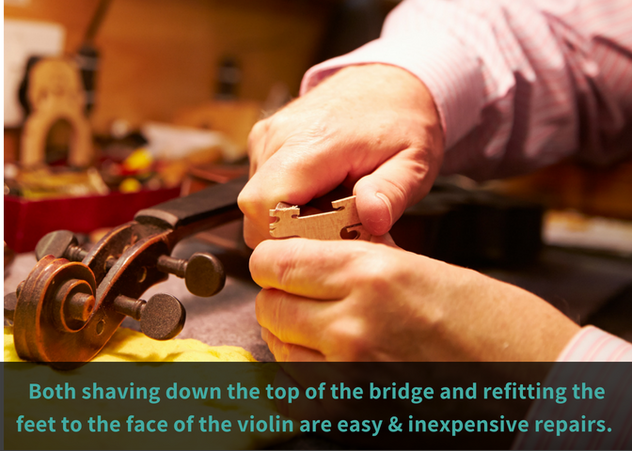|
Learn how to choose the best violin possible by inspecting the craftsmanship of the instrument and feel confident in knowing what to ask the seller with this 14 part tutorial and checklist that includes a free PDF checklist to download and take with when viewing instruments and an accompanying video tutorial. This is part 2 of 2 from the How to Buy a Used Violin series. The first part shares 9 guidelines to help take the confusion out of the process of purchasing a used instrument. The second part focuses solely on what to look for when inspecting the craftsmanship of a used violin. Click HERE to view Part 1: 9 Guidelines for Buying a Used Violin (+ video and free PDF download). When purchasing any violin and especially a used violin, it is important to do a thorough inspection of the craftsmanship of the violin, bow and violin case before buying. Any repair or necessary upgrades such as new strings, bow hair or violin case will increase your investment and should be budgeted for. Below is a checklist of what to review when inspecting a used violin. I recommend downloading the accompanying PDF to bring with you when viewing instruments and viewing the accompanying tutorial video to see demonstrations. 1 - Are the seams glued shut? Visually inspect and gently tap around the outside of the instrument to hear a change in the acoustics where seams have come unglued. 2- Are there any cracks? Do the cracks stop at the purfling or extend all the way to the edge? Cracks that stop at the purfling are normal in older instruments and repairable if done in a timely manner. 3- Is the purfling inlaid or painted on? Actual inlaid purfling protects the instrument and indicates a higher quality construction. Purfling that is painted on is solely decorative, does not protect the instrument and usually indicates a lesser quality instrument. 4- Is the bridge too high and/or not properly fitted to the instrument? You will know it is too high if it hurts your fingers to play. This is an easy and economical fix that a local violin shop can accomplish. To see if the bridge is properly fitted to the face of the instrument visually inspect for a solid fitting between the feet of the bridge and face of the violin. You can test this by taking a piece of paper to the edges of the feet of the bridge to see if you can slip it underneath. 5- Is the sound post in the correct location? The sound post is the dowel located vertically inside the violin and is held in place by the tension of the top and bottom plates of the violin. Sound posts are significant because they transfer tone via the vibrations made when the bow contacts the string. Sound posts are so important in creating the beauty of sound in a violin that they are sometimes referred to as the “âme,” a French word meaning soul or “anima,” the Italian word for soul. Sound posts need to be in a highly specific location in order for the instrument to produce an optimal sound. Sometimes a simple adjustment of the sound post makes a world of difference in the sound of a violin. It is worth playing around with this variable on an instrument that is catching your interest but just seems to be a little off in reaching its potential. 6- Do the pegs move easily and hold their grip? Ideally, pegs are easy to move and properly fitted to the holes in the pegbox which allows for ease of tuning and maintenance of pitch. 7- Is the bow stick warped? When the hair on the bow has been lost more on one side than the other then the bow will start to warp. Sometimes all that is needed to address this issue is a new bow rehair. However, if the bow has been left in this position for too long then the stick will have permanently been warped out of place and requires recambering. 8- Is there enough hair on the bow? Bows lose hair on a regular basis, this is normal and easily addressed with getting the bow rehaired. 9- Is the hair on the bow dirty? At the frog of the bow it is normal for approximately an inch of dirt to build upon the bow hair as a natural result of correct playing technique. However, often times hair has been touched throughout the length of the bow which results in slippery spots and compromises the tone. If this is the case then bow hair can either be cleaned or replaced. 10- Does the violin need new strings? New strings are essential in evaluating the potential of an instrument. Old strings create a dull sound and are not able to maintain the center of the pitch. The quality of strings will also make a difference and in my opinion, some of the least expensive strings will compromise the quality of an instrument and should be avoided unless it is the only option available to your situation. 11- Is the chinrest adequate for your playing needs or will it need to be replaced? The chinrest should help a player make the instrument feel ergonomic and facilitate natural playing. If you like the instrument overall but it feels uncomfortable know that there are dozens of different styles of chinrests and even some custom fitted options to help facilitate your unique playing needs. 12- Does the violin come with a case? Not every violin includes the case so do not assume this will be added into your purchase. If the instrument does include a case check if the case closes securely, is weatherproof and truly protects the instrument. Additional Questions to Ask the Seller: 13- Does the instrument come with any accessories like a shoulder pad, music stand or sheet music materials? It never hurts to ask if extra things are included in your purchase. 14- Who is the maker of the violin, what model is it and when was it made? The label on the inside of the instrument (visible by looking inside the “F” holes) will list this information. You need to know that makers have several tiers of instruments ranging from lower to higher quality models. In other words, just knowing the maker is not enough and you will also need to research what levels of violins that particular maker creates. Click on the image below to download this checklist.
5 Comments
Ira Hsu
8/29/2018 04:56:53 am
Very helpful post, Heather! As an idea for a follow-up article, I thought about this: how do you tell if purfling is inlaid or not? (different grain of wood?)
Reply
Heather Ann Figi
8/30/2018 07:22:33 am
Hello,
Reply
10/26/2018 07:28:36 pm
Great article. When shopping for a violin with one of my daughters, we seriously looked at one, then found that several seams were open. We looked at a number of other violins this dealer was selling and many had open seams! I could not believe she could stand there and tell us about the quality of her violins and the abilities of her repair person, and still be selling all these violins with open seams! Always, always inspect the instrument!
Reply
Heather Figi
10/27/2018 06:22:51 am
Hello, Thank you for taking a moment to share. That is especially surprisingly since a majority of open seams are so easy to repair. Thanks again, Heather
Reply
Leave a Reply. |
Categories
All
Archives
February 2024
AuthorHi! It's me, Heather. I absolutely love working on the Music for Young Violinists project and all the many facets: blogging, website, music, teaching materials, freebies, videos, newsletter and giveaway contests. The best part is connecting with you so feel free to drop me a line. You can learn more about me on the "ABOUT" page. Thanks! |








 RSS Feed
RSS Feed
